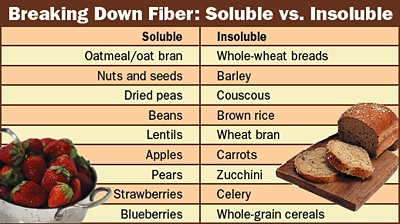To Your Health
February, 2007 (Vol. 01, Issue 02) |
|
|
The Fundamentals of Fiber
By Editorial Staff
Most people don't eat enough fiber, despite its health benefits - research evidence links inadequate fiber intake with conditions such as heart disease, type 2 diabetes, inflammation of the intestine and constipation, among other things.
The current recommendation for dietary fiber intake for adults is 20-35 grams per day. However, the average person consumes only 14-15 grams of fiber a day.
Many people have more questions than answers when the topic of fiber even comes up. What foods are the best sources of fiber? How do we incorporate more fiber into our diets?
A key distinction to be aware of is the difference between soluble and insoluble fiber. Fiber that partially dissolves in water is called soluble. Conversely, fiber that doesn't dissolve in water is called insoluble. Both promote health, but in different ways.
In terms of function, here's a key distinction between soluble and insoluble fiber: Soluble fiber slows digestion and helps the body absorb vital nutrients, while insoluble fiber adds bulk to the stool, helping foods pass through the stomach and intestines. To help increase daily fiber intake, experts recommend eating whole fruits instead of drinking fruit juices; replacing white rice, bread and pasta with brown rice and whole-grain products; eating whole-grain breakfast cereals; eating raw vegetables instead of chips, crackers and sweets when craving a snack; substituting legumes for meat in soups and chili; and trying Indian or Middle Eastern dishes that use whole grains and legumes as part of their main meal, salads and side dishes.


